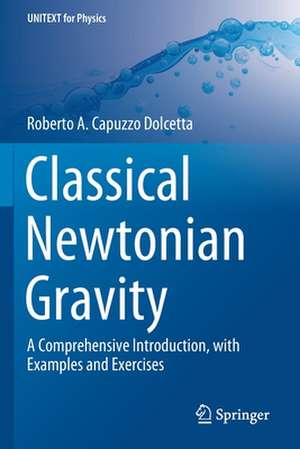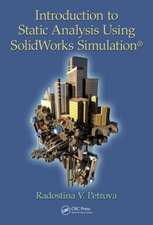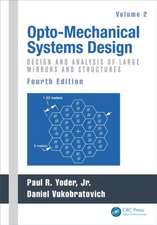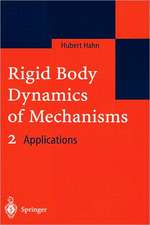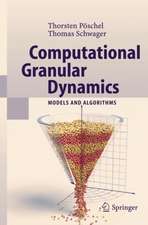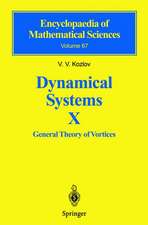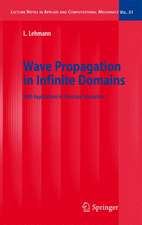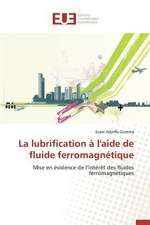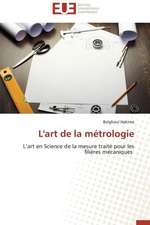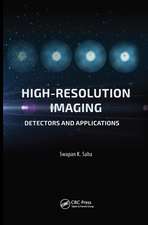Classical Newtonian Gravity: A Comprehensive Introduction, with Examples and Exercises: UNITEXT for Physics
Autor Roberto A. Capuzzo Dolcettaen Limba Engleză Paperback – 7 oct 2020
The book is aimed at those who wish to progress further beyond an initial bachelor degree, onward to a master degree, and a PhD. It is also a valuable resource for postgraduates and active researchers in the field.
| Toate formatele și edițiile | Preț | Express |
|---|---|---|
| Paperback (1) | 382.18 lei 6-8 săpt. | |
| Springer International Publishing – 7 oct 2020 | 382.18 lei 6-8 săpt. | |
| Hardback (1) | 500.42 lei 6-8 săpt. | |
| Springer International Publishing – 7 oct 2019 | 500.42 lei 6-8 săpt. |
Din seria UNITEXT for Physics
- 17%
 Preț: 362.52 lei
Preț: 362.52 lei - 13%
 Preț: 355.11 lei
Preț: 355.11 lei - 17%
 Preț: 459.63 lei
Preț: 459.63 lei -
 Preț: 358.22 lei
Preț: 358.22 lei - 19%
 Preț: 470.38 lei
Preț: 470.38 lei - 15%
 Preț: 603.83 lei
Preț: 603.83 lei -
 Preț: 351.07 lei
Preț: 351.07 lei - 17%
 Preț: 429.71 lei
Preț: 429.71 lei -
 Preț: 358.01 lei
Preț: 358.01 lei -
 Preț: 357.88 lei
Preț: 357.88 lei - 17%
 Preț: 493.75 lei
Preț: 493.75 lei -
 Preț: 489.87 lei
Preț: 489.87 lei - 15%
 Preț: 582.95 lei
Preț: 582.95 lei - 15%
 Preț: 534.17 lei
Preț: 534.17 lei -
 Preț: 426.23 lei
Preț: 426.23 lei - 17%
 Preț: 395.01 lei
Preț: 395.01 lei - 17%
 Preț: 368.42 lei
Preț: 368.42 lei - 17%
 Preț: 395.64 lei
Preț: 395.64 lei -
 Preț: 458.61 lei
Preț: 458.61 lei - 15%
 Preț: 474.31 lei
Preț: 474.31 lei -
 Preț: 456.66 lei
Preț: 456.66 lei -
 Preț: 404.13 lei
Preț: 404.13 lei -
 Preț: 327.48 lei
Preț: 327.48 lei -
 Preț: 453.39 lei
Preț: 453.39 lei -
 Preț: 491.21 lei
Preț: 491.21 lei -
 Preț: 828.92 lei
Preț: 828.92 lei -
 Preț: 724.07 lei
Preț: 724.07 lei -
 Preț: 489.30 lei
Preț: 489.30 lei - 15%
 Preț: 509.74 lei
Preț: 509.74 lei - 15%
 Preț: 528.63 lei
Preț: 528.63 lei - 15%
 Preț: 511.05 lei
Preț: 511.05 lei - 15%
 Preț: 782.69 lei
Preț: 782.69 lei - 18%
 Preț: 796.13 lei
Preț: 796.13 lei -
 Preț: 351.06 lei
Preț: 351.06 lei - 15%
 Preț: 667.20 lei
Preț: 667.20 lei - 15%
 Preț: 499.77 lei
Preț: 499.77 lei - 15%
 Preț: 597.20 lei
Preț: 597.20 lei -
 Preț: 387.96 lei
Preț: 387.96 lei -
 Preț: 395.85 lei
Preț: 395.85 lei -
 Preț: 338.43 lei
Preț: 338.43 lei -
 Preț: 399.88 lei
Preț: 399.88 lei
Preț: 382.18 lei
Nou
Puncte Express: 573
Preț estimativ în valută:
73.14€ • 79.42$ • 61.44£
73.14€ • 79.42$ • 61.44£
Carte tipărită la comandă
Livrare economică 22 aprilie-06 mai
Preluare comenzi: 021 569.72.76
Specificații
ISBN-13: 9783030258481
ISBN-10: 3030258483
Pagini: 176
Ilustrații: XVI, 176 p. 34 illus., 3 illus. in color.
Dimensiuni: 155 x 235 mm
Greutate: 0.28 kg
Ediția:1st ed. 2019
Editura: Springer International Publishing
Colecția Springer
Seria UNITEXT for Physics
Locul publicării:Cham, Switzerland
ISBN-10: 3030258483
Pagini: 176
Ilustrații: XVI, 176 p. 34 illus., 3 illus. in color.
Dimensiuni: 155 x 235 mm
Greutate: 0.28 kg
Ediția:1st ed. 2019
Editura: Springer International Publishing
Colecția Springer
Seria UNITEXT for Physics
Locul publicării:Cham, Switzerland
Cuprins
Chapter 1.- Elements of Vector Calculus.- 1.1 Vector Functions of Real Variables.- 1.2 Limits of vector Functions.- 1.3 Derivatives of Vector Functions.- 1.3.1 Geometrie Interpretation.- 1.4 Integrals of Vector Functions.- 1.5 The Formal Operator Nabla, ∇.- 1.5.1 ∇ in Polar Coordinates.- 1.5.2 ∇ in Cylindrical Coordinates.- 1.6 The Divergence Operator.- 1.7 The Curl Operator.- 1.8 Divergence and Curl by Means of ∇.- 1.8.1 Spherical Polar Coordinates.- 1.8.2 Cylindrieal Coordinates.- 1.9 Vector Fields.- 1.9.1 Field Lines.- 1.10 Divergence Theorem.- 1.10.1 Velocity Fields.- 1.10.2 Continuity Equation.- 1.10.3 Field Lines of Solenoidal Fields.- Chapter 2 Potential Theory.- Discrete mass distributions.- 2.1 Single particle gravitational potential.- 2.2 The gravitating N body case.- 2.3 Mechanical Energy of the N bodies.- 2.4 The Scalar Virial Theorem.- 2.4.1 Consequenees of the Virial Theorem.- 2.5 Newtonian Gravitational Force and Potential.- 2.6 Gauss Theorem.- 2.7 Gravitational Potential Energy.- 2.8 Newton’s Theorems.- Chapter 3.- Central Force Fields.- 3.1 Force and Potential of a Spherical Mass Distribution.- 3.2 Circular orbits.- 3.2 Potential of a Homogeneous Sphere.- 3.3.1 Quality of Motion.- 3.3.2 Particle Trajectories.- 3.4 Periods of Oscillations.- 3.4.1 Radial and Azimuthal Oscillations.- 3.4.2 Radial Oscillations in a Homogeneous Sphere.- 3.4.3 Radial Oscillations in a Point Mass Potential.- 3.5 The Isochrone Potential.- 3.6 The Inverse Problem in Spherical Distributions.- Chapter 4.- Potential Series Developments.- 4.1 Fundamental Solution of Laplace'sChapter 1.- Elements of Vector Calculus.- 1.1 Vector Functions of Real Variables.- 1.2 Limits of vector Functions.- 1.3 Derivatives of Vector Functions.- 1.3.1 Geometrie Interpretation.- 1.4 Integrals of Vector Functions.- 1.5 The Formal Operator Nabla, ∇.- 1.5.1 ∇ in Polar Coordinates.- 1.5.2 ∇ in Cylindrical Coordinates.- 1.6 The Divergence Operator.- 1.7 The Curl Operator.- 1.8 Divergence and Curl by Means of ∇.- 1.8.1 Spherical Polar Coordinates.- 1.8.2 Cylindrieal Coordinates.- 1.9 Vector Fields.- 1.9.1 Field Lines.- 1.10 Divergence Theorem.- 1.10.1 Velocity Fields.- 1.10.2 Continuity Equation.- 1.10.3 Field Lines of Solenoidal Fields.- Chapter 2 Potential Theory.- Discrete mass distributions.- 2.1 Single particle gravitational potential.- 2.2 The gravitating N body case.- 2.3 Mechanical Energy of the N bodies.- 2.4 The Scalar Virial Theorem.- 2.4.1 Consequenees of the Virial Theorem.- 2.5 Newtonian Gravitational Force and Potential.- 2.6 Gauss Theorem.- 2.7 Gravitational Potential Energy.- 2.8 Newton’s Theorems.- Chapter 3.- Central Force Fields.- 3.1 Force and Potential of a Spherical Mass Distribution.- 3.2 Circular orbits.- 3.2 Potential of a Homogeneous Sphere.- 3.3.1 Quality of Motion.- 3.3.2 Particle Trajectories.- 3.4 Periods of Oscillations.- 3.4.1 Radial and Azimuthal Oscillations.- 3.4.2 Radial Oscillations in a Homogeneous Sphere.-3.4.3 Radial Oscillations in a Point Mass Potential.- 3.5 The Isochrone Potential.- 3.6 The Inverse Problem in Spherical Distributions.- Chapter 4.- Potential Series Developments.- 4.1 Fundamental Solution of Laplace's Equation.- 4.2 Harmonic Functions.- 4.3 Legendre's Polynomials.- 4.4 Recursive Relations.- 4.4.1 First Recursive Relation.- 4.4.2 Second Recursive Relation.- 4.5 Legendre Differential Equation.- 4.6 Orthogonality of Legendre's Polynomials.- 4.7 Development in Series of Legendre's Polynomials.- 4.8 Rodrigues Formula Chapter 5.- Harmonic and Homogeneous Polynomials.- 5.1 Spherical Harmonics.- 5.2 Solution of the Differential equations for Sm(θ, ϕ).- 5.3 The Solution in ϕ.- 5.4 A note on the Associated Legendre Differential Equation.- 5.5 Zonal, Sectorial and Tesseral Spherical Harmonics.- 5.5.1Orthogonality Properties.- Chapter 6.- Series of Spherical Harmonics.- 6.1 Potential Developments Out of a Mass Distribution.- 6.2 The External Earth Potential.- 6.3 Exercises.
Notă biografică
Roberto A. Capuzzo-Dolcetta worked for 20 years as a full-time researcher at the University of Roma La Sapienza, until, in July 2000, he became Associate Professor in Astronomy and Astrophysics, where he is now teaching Fluid dynamics for Astrophysics and Theoretical Astrophysics. He has also a long term experience in teaching Gravitational Physics and Theoretical Mechanics at both undergraduate and graduate level. He has also been teaching in the United States, delivering, for instance, the undergraduate course on Extragalactic Astronomy and Cosmology at the University of Washington and Seattle and presenting lectures for graduate students at Boston University. Since May 2010 he has been a scientific reviewer for ISCRA (Italian Super Computing Research Allocation) at CINECA and leader of the panel of Universe Science of the Access Committee of PRACE (the european infrastructure for super computing). His research activity is mainly theoretical, in the field of stellar clusters, bothgalactic and extragalactic. He is an expert in sophisticated numerical methods to deal with large self-gravitating N-body systems. He has obtained important results concerning the evolution and dynamics of the globular cluster systems in galaxies, and proposed a new original explanation for mass accretion and activity of galactic nuclei. He is the author of more than 200 scientific papers in international journals.
Textul de pe ultima copertă
This textbook offers a readily comprehensible introduction to classical Newtonian gravitation, which is fundamental for an understanding of classical mechanics and is particularly relevant to Astrophysics. The opening chapter recalls essential elements of vectorial calculus, especially to provide the formalism used in subsequent chapters. In chapter two Classical Newtonian gravity theory for one point mass and for a generic number N of point masses is then presented and discussed. The theory for point masses is naturally extended to the continuous case. The third chapter addresses the paradigmatic case of spherical symmetry in the mass density distribution (central force), with introduction of the useful tool of qualitative treatment of motion. Subsequent chapters discuss the general case of non-symmetric mass density distribution and develop classical potential theory, with elements of harmonic theory, which is essential to understand the potential development in series of the gravitational potential, the subject of the fourth chapter. Finally, in the last chapter the specific case of motion of a satellite around the earth is considered. Examples and exercises are presented throughout the book to clarify aspects of the theory.
The book is aimed at those who wish to progress further beyond an initial bachelor degree, onward to a master degree, and a PhD. It is also a valuable resource for postgraduates and active researchers in the field.
The book is aimed at those who wish to progress further beyond an initial bachelor degree, onward to a master degree, and a PhD. It is also a valuable resource for postgraduates and active researchers in the field.
Caracteristici
Provides a readily comprehensible introduction to classical Newtonian gravitation Includes numerous examples and exercises to clarify aspects of the theory Considers the specific case of motion of a satellite around the earth, as well as other cases of orbits of astrophysical interest
